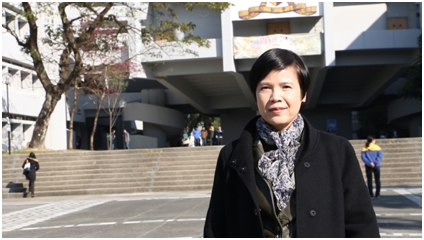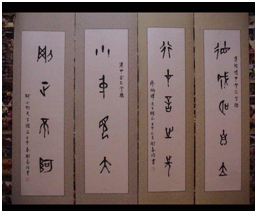PEOPLE |
|
Dr. XIE Chun Ling Senior Lecturer (Putonghua), University Programme Section Ex-officio member, Academic Activities Division |
 |
Editor’s note: Xie
laoshi is one of the few teachers in the Centre whose mother tongue is both
Putonghua and Cantonese. Her hilarious jokes originated from the contrast
between Cantonese and Putonghua had made Ellen MAK, the editor, burst into
laughter. Xie laoshi pursues ardently in Chinese language and culture and
has ample Chinese language teaching experience in both mainland China and
Hong Kong. She spent twenty years to compile a dictionary on Chinese
Etymology. She is also an archaic script calligrapher whose works have been
exhibited in Hong Kong, China and overseas. We are glad to have Xie laoshi
in this issue of PEOPLE to share with us her discoveries in the teaching and
research.
1.
How
did you get connected with CUHK?
My children and I
emigrated from Guangzhou to Hong Kong in 2003. Coincidentally, CLC was
recruiting Putonghua teacher. I applied for the position successfully and
have been serving until now. I teach Putonghua mainly to local
undergraduates with Chinese character course to international students.
TEACHING & LEARNING
2.
Personal funny story on the contrast between Cantonese and Putonghua
There is a question in the Centre’s COPA Putonghua public test question
bank. The situational context of the question was “on the plane”. The
question asked, “If a lady could not reach the overhead luggage compartment,
should a gentleman extend his helping hands?” A male student answered this
question. Initially I heard like this, “When a lady needs help, a gentleman
should certainly paw her.” Actually, the Cantonese sound1of the first word
is the same for “being slow” and “to provide a helping hand” (wùhn/ wun4).
This examinee had an inter-language negative transfer from “huǎn”,
the Putonghua sound of the first character for being slow to “yuán”,
the first character for providing assistance. So, “yuánshǒu”
(to provide a helping hand) sounded like “huáng
shǒu” (to paw a woman).
3.
Can you illustrate with more examples on
the Putonghua errors frequently made by local students?
(Click
to see video)![]()
Diversity in pronunciation,
vocabulary and syntax can be found between Putonghua and Cantonese and the
biggest amongst exists in pronunciation. For example, Cantonese has no
retroflex consonants. Students confuse “zhǔ
lì” (a main force) with “zǔ lì” (resistance); “yúchì”
(shark’s
fin) with “yúcì”
(fish
bone). In the area of tones, students tend to mispronounce “zhù
jiào” (tutor) as “zhū jiào” (pig grunt); “jī chǎng” (airport) as “jī cháng”
(chicken intestines); “zhòng diǎn” (a key point) as “zhōng diǎn”
(part-time). For consonants, some students intended to say “a shop has a
discount (dǎ zhé)” and ended up slurred “a shop can be robbed (dǎ jié)”.
Some mispronounced shàng jìn (being
enterprising)
as shàng jìng (being photogenic).
Regarding
vocabulary, there are discrepancies in between as well. I lived in the Shaw
College of CUHK for over 10 years. At the beginning, I often heard people
saying that the landmark of Shaw College is a sculpture called “Woman Legs”.
No matter what angles I viewed, I could not associate it with “leg”. Soon
after, I realized that Cantonese called the whole leg “jiǎo”,
and Putonghua called only the part below ankle “jiǎo”.
Difference can be found in between
the word used for grave
sweeping (“拜山”
and “掃墓”),
swimming (“游水”
and “游泳”)and
body check (“驗身”
and “體檢”).
In some cases, the different words do not refer to the same thing, e.g.
classroom (“班房”
≠ “教室”)
and photocopy (“影印”
≠ “複印”).
The most hilarious one that made Putonghua speakers convulsed with
laughter is
calling room-mate “室友”
as ”同房”
(sleeping together).
As for grammar, the variation in
between is not that big but we can still find some. For example in
Putonghua, the position of “多”
(many) and “少”
(a few) in a sentence. They are usually put in the front of a verb when they
are used as adverbial
modifier to a verb or an
adjective. E.g. “天涼少喝涼水,多穿一件衣服。”
In Cantonese, “多”and“少”
are usually placed after the verb, such as “食多啲”,
“賺多啲”
and “搵多啲”
etc.
4.
Share with us how language teaching is different between here and mainland
China. How did you adapt to it?
Before
coming to Hong Kong, I taught courses like contemporary Chinese and Chinese
etymology for many years in mainland universities. I was used to “one-voiced
class”, the traditional way to emphasize on knowledge teaching. Since
serving as language instructor in CLC, I have gradually apprehended the
distinctive features in language teaching: to lay stress on language
practices and not on knowledge impartation.
So, the teacher oriented lecture mode is not applicable to this new
environment and the new student targets. After 10 years more of teaching
practices, I have progressively shifted to student oriented and pragmatic
framework language use teaching approach. During lessons, I tried my best to
cultivate an environment close to real situation and context for students to
learn the language and guide them to use it appropriately. Thus, there is a
shift from “one-voiced class” to “all-voiced class”.
5.
You founded the new summer course
CPTH2203 “Chinese Characters and Reading Chinese”. What is special about
this course?
This course targeted non-local
students who are elementary Chinese learners. The features are teaching of
fundamental Chinese characters with reference to the source from oracle bone
script; to illustrate by the vivid expression of pictographs; to enhance
students to understand the structure, form and meaning of the early
characters. The association of a radical character root with the multiple
words formed by that root accelerated students’ character recognition.
6.
How did the Oracle Bone Scripts
facilitate the learning of Chinese language?
Oracle Bone
Inscription can be regarded as the gem in the treasure-house. They had been
buried under the ground for 3000 years and until year 1899 did they being
re-discovered. During the times, no revision, misrepresentation and
additional processing were made. From the text form to the recorded content
were kept authentic and original the way they were in the Shang Dynasty.
They are also regarded as the most reliable source of the historical
relics for the Shang Dynasty. Oracle Bone Scripts and the Chinese characters
used nowadays are derived from the same origin. Oracle Bone Scripts are the
closest to the origin of archaic scripts. By understanding Oracle Bone
Inscription, it helps us to comprehend the original meaning of a Chinese
character. In comparison to the Regular Scripts
we used today, we can understand the evolution of Chinese characters and
their development sequence.
PROFESSION
7.
The fate of being connected with
linguistics and etymology from undergraduate to doctoral study
I studied etymology in my undergraduate study. It was taught by
Prof. Zhang Gui-guang, a nationally renowned archaic script and etymology
expert who was also the director of Archaic Script and Etymology Research
Council. The vivid and lively illustration by Prof. Zhang on Oracle Bone
Script had led me into the magnificent world of archaic script. This has
given me life-long impact. After graduation, I continued my postgraduate
study in Chinese language history and professional archaic script etymology.
I still learned archaic script from Prof. Zhang. Under his guidance, I spent
20 years to compile and publish a dictionary on the evolution in the form
and meaning of Chinese Characters《The
Concise Chinese Dictionary》(published
by Commercial Press H.K. Ltd). I could say that Prof. Zhang is a crucial
person to me in my academic life.
During my doctoral study in HKU, my supervisor was Prof.
Shan
Zhou-yao,
an
internationally renowned archaic script scholar and chairperson of the
Chinese School at that time. Under his guidance, I completed and published
my second academic work, “A Study on the Empty Categories in the Oracle Bone
Inscriptions from the Shang Dynasty Ruins”. I am extraordinarily privileged
to learn from the 2 masters.
8.
How
did you embark on your journey to archaic script calligrapher?
During
the time when I was studying Etymology with Prof. Zhang, I always heard
about his demand on students in learning Chinese calligraphy. He said that
all etymologists are also Chinese calligraphers. In those days when one was
fresh and vigorous, everyone wanted to be “expert” and eventually we learned
Chinese calligraphy from him. As time passes, we came to comprehend his
intention behind of such demand. It was to let us to be thoroughly immersed
in the wonderful world of Chinese characters; to crave for knowledge and to
accomplish. After we wrote more, we knew the form, structure and the regular
pattern of the evolution of Chinese characters just like the back of our
hands.
9.
Share
with us your favorite calligraphy work.
That is an oracle
bone couplet scroll. The first line wrote “virtues before fame and
independence”, reminding us that as human we should not often seek ways to
get famous, but should establish good moral qualities. The second line wrote
“actions before words”. Paying lip service is not enough. Action is the most
important. They can be called the cardinal rule of humanhood.
10.
Academic plan for the upcoming 1 year
Being a
member of the Academic Activities Division, I aimed at optimizing the
existing teaching materials and to further develop advanced level course
materials. Besides, I hope to
try my utmost ability in mentoring new teachers; not because I taught
exemplarily, but to share the lessons I learned and to help making their
path straight.
BACKGROUND &
HOBBIES
11. How did your family shape your personal growth?
My mother was born to an affluent family. Various family members got
official ranks from the imperial examinations. By the early years of the
Republic of China, my maternal grandfather was a graduate from the law
school of Sun Yat-Sen University. My father was born in a family of
teachers. My grandmother could sing with the “Three Character Classic”,
which had eventually become the lullaby of my life. I wonder if the blend of
scholarly and teaching genes in my blood had nurtured the fundamental
characteristics in my life.
12.
Hobbies
I like reading
during spare time. Sometimes, I write prose, play piano, practice
calligraphy and carve seals. Yet, reading is my love. Reading can enrich
one’s life, because books unveil to you the known and the unknown, the facts
and the probabilities. Books are a piece of mirror to reveal the
multi-facets of life. Books can transform the many impossible into possible
and to immerse you in a unique experience you would never could encounter by
yourself in your life. That is why I could give up not chasing after popular
TV drama and not to watch a programme for the second time. But a good book
will reside next to my pillow, and I read it over and over again.
MESSAGE TO THE
STUDENTS
13.
Any
advice to Putonghua learners whose mother tongue is Cantonese?
If 5
years old or below is the critical period for learning languages, then all
the students in the university are far beyond the age. So, I often told my
students that, the key to excellent Putonghua is nothing more than to listen
often and to speak often. Frequent listening nurtures the sense of a
language and more speaking cultivates fluency. There is no short cut at all.
14.
Gratifying moments
|
Oracle bone script calligraphy work of Xie laoshi |
About Us
| Contact Us
| Privacy
|
Disclaimer
Copyright © 2016.
All Rights Reserved. The Chinese University of Hong Kong.

